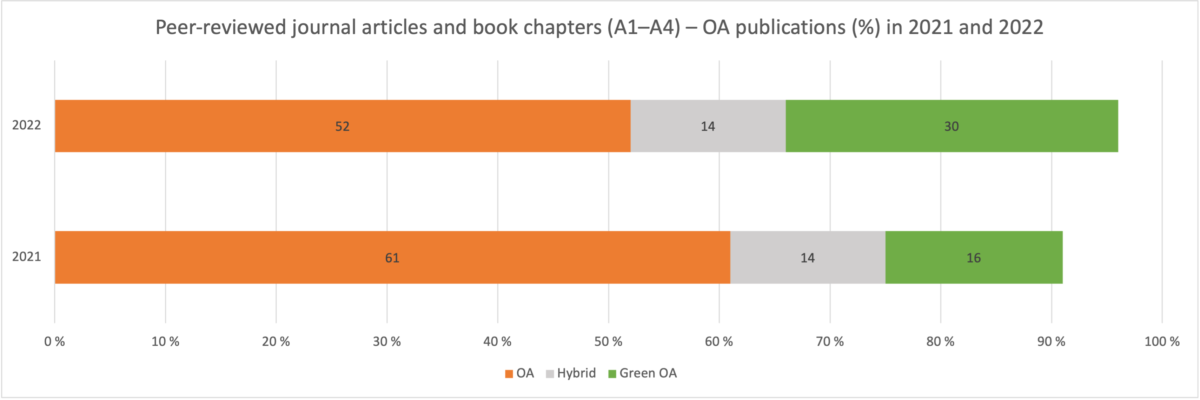Open Access publications on the rise at Uniarts
Open availability of scientific publications increased again at Uniarts.

Harri Ollikainen, Information specialist, Uniarts Helsinki
Open availability of scientific publications increased again at Uniarts, when 96% of peer-reviewed articles and book chapters (Ministry of Education and Culture’s publication types A1–A4) published in 2022 were Open Access.
The importance of self-archiving
Openness of publications was high to begin with, as almost half of all publications were published in Open Access channels. At the same time, nearly all publications that could be self-archived were archived in Uniarts Helsinki’s institutional repository Taju. Practically all major international publishers allow authors to self-archive their manuscripts with or without embargo periods, so the cases where the manuscript wasn’t allowed to be self-archived were rare exceptions. Additionally, some articles were published in hybrid journals.
The Open Access rate for publications was high previously (91% in 2021), but with the new publishing policy introduced last year Uniarts started to require researchers to self-archive their paywalled articles. It can be argued that the new publishing policy has increased the openness of publications, but at the same time researchers at Uniarts are clearly in favour of openness anyway and see the importance of Open Access from the point of view social justice, for instance.
It is however notable that while the openness of articles has increased, the share of Gold and Diamond Open Access publications decreased from 2021 and the share of hybrid publications remained the same. This was effectively levelled by the increased share of self-archived publications (Green OA), which almost doubled from the previous year.

Paths to openness
At Uniarts there’s an Article Processing Charge (APC) compensation procedure, or APC fund, that researchers can use to publish in Gold Open Access journals. There are actually much more Diamond OA journals (Open Access journals that don’t charge APCs) than Gold OA journals, so author-facing charges are not the default. Gold and Diamond OA journals can be browsed and searched in the DOAJ database. It’s also possible to filter journals in JUFO portal based on their Open Access status.
Self-archiving has been made easier in the new UniartsCRIS system, where researchers can attach their manuscript to be self-archived when they report the publication. Researchers can check the publisher’s self-archiving policy themselves and send the correct version of their article to the library via UniartsCRIS. The library also checks the reported publications in UniartsCRIS: if the article is published in a subscription journal and the author hasn’t attached the manuscript to be self-archived, the library checks the publisher’s policy and requests the author for the correct version to be archived in Taju.
So, there are many paths to publish openly. Which path increases and which decreases in 2023 remains to be seen. There are enough many issues with hybrid journals, that at least it’s in no one’s (except for-profit publishers’) interest to increase the share of hybrid publications.
Development of Taju
The library has received a few questions from researchers whether it would be possible to self-archive other than scientific publications, such as professional or popularized articles, in Taju. We have tentatively surveyed the possibilities and in principle this might be a good idea in terms of societal impact and visibility. What technical solutions regarding e.g. metadata fields and collection structures are needed to achieve this, is however still under review.
We are able to change and modify certain things in Taju, but a lot is tied to the development of the software underlying Taju. The National Library of Finland is responsible for the development of the repositories they host, and they are preparing for a major update in the repositories, which is why there will be no major improvements to the current version. Essentially, the development of Taju is ongoing in two tracks: the National Library is responsible for the technical development and hosting of the repository, while Uniarts library can make some local changes and improvements to Taju and pass on larger requests for development to the National Library.
Data sources: Uniarts Cris and Science and research in Finland webpage
Tekstejä taiteista
Monimuotoinen julkaisutoimintamme käsittelee esittävän taiteen, kuvataiteen, musiikin, tutkimuksen ja taiteellisen tutkimuksen kysymyksiä. Tästä blogista voit lukea julkaisutoimintamme kuulumisia. Lisätietoa julkaisujen saatavuudesta löydät Taideyliopiston Julkaisut-sivulta.
Uusimmat julkaisut
Seuraa blogia